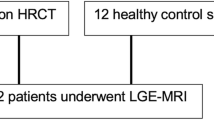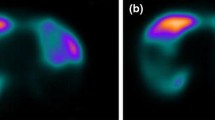Abstract
Purpose
Distinct morphological emphysema phenotypes were assessed by CT to show characteristic perfusion defect patterns.
Material/Methods
Forty-one patients with severe emphysema (GOLD III/IV) underwent three-dimensional high resolution computed tomography (3D-HRCT) and contrast-enhanced magnetic resonance (MR) perfusion. 3D-HRCT data was visually analyzed for emphysema phenotyping and quantification by consensus of three experts in chest-radiology. The predominant phenotype per segment was categorized as normal, centrilobular, panlobular or paraseptal. Segmental lung perfusion was visually analyzed using six patterns of pulmonary perfusion (1-normal; 2-mild homogeneous reduction in perfusion; 3-heterogeneous perfusion without focal defects; 4-heterogeneous perfusion with focal defects; 5-heterogeneous absence of perfusion; 6-homogeneous absence of perfusion), with the extent of the defect given as a percentage.
Results
730 segments were evaluated. CT categorized 566 (78 %) as centrilobular, 159 (22 %) as panlobular and 5 (<1 %) as paraseptal with no normals. Scores with regards to MR perfusion patterns were: 1–0; 2–0; 3–28 (4 %); 4–425 (58 %); 5–169 (23 %); 6–108 (15 %).
The predominant perfusion pattern matched as follows: 70 % centrilobular emphysema - heterogeneous perfusion with focal defects (score 4); 42 % panlobular - homogeneous absence of perfusion (score 5); and 43 % panlobular - heterogeneous absence of perfusion (score 6).
Conclusion
MR pulmonary perfusion patterns correlate with the CT phenotype at a segmental level in patients with severe emphysema.
Key points
• MR perfusion patterns correlate with the CT phenotype in emphysema.
• Reduction of MR perfusion is associated with loss of lung parenchyma on CT
• Centrilobular emphysema shows heterogeneous perfusion reduction while panlobular emphysema shows loss of perfusion.



Similar content being viewed by others
References
GOLD (2009) Global Initiative for Chronic Obstructive Lung Disease (GOLD). http://www.goldcopd.com/
Han MK, Agusti A, Calverley PM, Celli BR, Criner G, Curtis JL, Fabbri LM, Goldin JG, Jones PW, Macnee W, Make BJ, Rabe KF, Rennard SI, Sciurba FC, Silverman EK, Vestbo J, Washko GR, Wouters EF, Martinez FJ (2010) Chronic obstructive pulmonary disease phenotypes: the future of COPD. Am J Respir Crit Care Med 182:598–604
Lynch DA (2008) Imaging of small airways disease and chronic obstructive pulmonary disease. Clin Chest Med 29:165–179
Kinsella M, Müller N, Abboud R, Morrison N, DyBuncio A (1990) Quantitation of emphysema by computed tomography using a "density mask" program and correlation with pulmonary function tests. Chest 97:315–321
Nakano Y, Muro S, Sakai H, Hirai T, Chin K, Tsukino M, Nishimura K, Itoh H, Pare PD, Hogg JC, Mishima M (2000) Computed tomographic measurements of airway dimensions and emphysema in smokers. Correlation with lung function. Am J Respir Crit Care Med 162:1102–1108
Han MK, Bartholmai B, Liu LX, Murray S, Curtis JL, Sciurba FC, Kazerooni EA, Thompson B, Frederick M, Li D, Schwarz M, Limper A, Freeman C, Landreneau RJ, Wise R, Martinez FJ (2009) Clinical significance of radiologic characterizations in COPD. Copd 6:459–467
Bon JM, Leader JK, Weissfeld JL, Coxson HO, Zheng B, Branch RA, Kondragunta V, Lee JS, Zhang Y, Choi AM, Lokshin AE, Kaminski N, Gur D, Sciurba FC (2009) The influence of radiographic phenotype and smoking status on peripheral blood biomarker patterns in chronic obstructive pulmonary disease. PLoS One 4:e6865
Coxson HO, Mayo J, Lam S, Santyr G, Parraga G, Sin DD (2009) New and Current Clinical Imaging Techniques To Study Chronic Obstructive Pulmonary Disease. Am J Respir Crit Care Med 180:588–597
Sandek K, Bratel T, Lagerstrand L, Rosell H (2002) Relationship between lung function, ventilation-perfusion inequality and extent of emphysema as assessed by high-resolution computed tomography. Respir Med 96:934–943
Toma TP, Hopkinson NS, Hillier J, Hansell DM, Morgan C, Goldstraw PG, Polkey MI, Geddes DM (2003) Bronchoscopic volume reduction with valve implants in patients with severe emphysema. Lancet 361:931–933
Yim AP, Hwong TM, Lee TW, Li WW, Lam S, Yeung TK, Hui DS, Ko FW, Sihoe AD, Thung KH, Arifi AA (2004) Early results of endoscopic lung volume reduction for emphysema. J Thorac Cardiovasc Surg 127:1564–1573
Stoller JK, Gildea TR, Ries AL, Meli YM, Karafa MT (2007) Lung volume reduction surgery in patients with emphysema and alpha-1 antitrypsin deficiency. Ann Thorac Surg 83:241–251
Wood DE, McKenna RJ Jr, Yusen RD, Sterman DH, Ost DE, Springmeyer SC, Gonzalez HX, Mulligan MS, Gildea T, Houck WV, Machuzak M, Mehta AC (2007) A multicenter trial of an intrabronchial valve for treatment of severe emphysema. J Thorac Cardiovasc Surg 133:65–73
Molinari F, Fink C, Risse F, Tuengerthal S, Bonomo L, Kauczor HU (2006) Assessment of differential pulmonary blood flow using perfusion magnetic resonance imaging: comparison with radionuclide perfusion scintigraphy. Invest Radiol 41:624–630
Ley-Zaporozhan J, Ley S, Eberhardt R, Weinheimer O, Fink C, Puderbach M, Eichinger M, Herth F, Kauczor HU (2007) Assessment of the relationship between lung parenchymal destruction and impaired pulmonary perfusion on a lobar level in patients with emphysema. Eur J Radiol 63:76–83
Martinez FJ, Foster G, Curtis JL, Criner G, Weinmann G, Fishman A, DeCamp MM, Benditt J, Sciurba F, Make B, Mohsenifar Z, Diaz P, Hoffman E, Wise R (2006) Predictors of mortality in patients with emphysema and severe airflow obstruction. Am J Respir Crit Care Med 173:1326–1334
Fishman A, Martinez F, Naunheim K, Piantadosi S, Wise R, Ries A, Weinmann G, Wood DE (2003) A randomized trial comparing lung-volume-reduction surgery with medical therapy for severe emphysema. N Engl J Med 348:2059–2073
Iwasawa T, Takahashi H, Ogura T, Asakura A, Gotoh T, Kagei S, Nishimura J, Obara M, Inoue T (2007) Correlation of lung parenchymal MR signal intensity with pulmonary function tests and quantitative computed tomography (CT) evaluation: A pilot study. J Magn Reson Imaging 26:1530–1536
Ley-Zaporozhan J, Ley S, Eberhardt R, Kauczor HU, Heussel CP (2010) Visualization of morphological parenchymal changes in emphysema: Comparison of different MRI sequences to 3D-HRCT. Eur J Radiol 73:43–49
Euler U, Liljestrand G (1946) Observations on the pulmonary arterial blood pressure in the cat. Acta Physiol Scand 12:301–320
Cederlund K, Hogberg S, Jorfeldt L, Larsen F, Norman M, Rasmussen E, Tylen U (2003) Lung perfusion scintigraphy prior to lung volume reduction surgery. Acta Radiol 44:246–251
Thabut G, Dauriat G, Stern JB, Logeart D, Levy A, Marrash-Chahla R, Mal H (2005) Pulmonary hemodynamics in advanced COPD candidates for lung volume reduction surgery or lung transplantation. Chest 127:1531–1536
Amundsen T, Torheim G, Kvistad KA, Waage A, Bjermer L, Nordlid KK, Johnsen H, Asberg A, Haraldseth O (2002) Perfusion abnormalities in pulmonary embolism studied with perfusion MRI and ventilation-perfusion scintigraphy: An intra-modality and inter-modality agreement study. J Magn Reson Imaging 15:386–394
Morino S, Toba T, Araki M, Azuma T, Tsutsumi S, Tao H, Nakamura T, Nagayasu T, Tagawa T (2006) Noninvasive assessment of pulmonary emphysema using dynamic contrast-enhanced magnetic resonance imaging. Exp Lung Res 32:55–67
Ohno Y, Hatabu H, Murase K, Higashino T, Kawamitsu H, Watanabe H, Takenaka D, Fujii M, Sugimura K (2004) Quantitative assessment of regional pulmonary perfusion in the entire lung using three-dimensional ultrafast dynamic contrast-enhanced magnetic resonance imaging: Preliminary experience in 40 subjects. J Magn Reson Imaging 20:353–365
Jang YM, Oh YM, Seo JB, Kim N, Chae EJ, Lee YK, Lee SD (2008) Quantitatively assessed dynamic contrast-enhanced magnetic resonance imaging in patients with chronic obstructive pulmonary disease: correlation of perfusion parameters with pulmonary function test and quantitative computed tomography. Invest Radiol 43:403–410
Fan L, Xia Y, Guan Y, Zhang TF, Liu SY (2014) Characteristic features of pulmonary function test, CT volume analysis and MR perfusion imaging in COPD patients with different HRCT phenotypes. Clin Respir J 8:45–54
Orr R, Smith LJ, Cuttica MJ (2012) Pulmonary hypertension in advanced chronic obstructive pulmonary disease. Curr Opin Pulm Med 18:138–143
Haimovici JB, Trotman-Dickenson B, Halpern EF, Dec GW, Ginns LC, Shepard JA, McLoud TC (1997) Relationship between pulmonary artery diameter at computed tomography and pulmonary artery pressures at right-sided heart catheterization. Massachusetts General Hospital Lung Transplantation Program. Acad Radiol 4:327–334
Kuriyama K, Gamsu G, Stern RG, Cann CE, Herfkens RJ, Brundage BH (1984) CT-determined pulmonary artery diameters in predicting pulmonary hypertension. Invest Radiol 19:16–22
Ng CS, Wells AU, Padley SP (1999) A CT sign of chronic pulmonary arterial hypertension: the ratio of main pulmonary artery to aortic diameter. J Thorac Imaging 14:270–278
Schmidt HC, Kauczor HU, Schild HH, Renner C, Kirchhoff E, Lang P, Iversen S, Thelen M (1996) Pulmonary hypertension in patients with chronic pulmonary thromboembolism: chest radiograph and CT evaluation before and after surgery. Eur Radiol 6:817–825
Arcasoy SM, Christie JD, Ferrari VA, Sutton MS, Zisman DA, Blumenthal NP, Pochettino A, Kotloff RM (2003) Echocardiographic assessment of pulmonary hypertension in patients with advanced lung disease. Am J Respir Crit Care Med 167:735–740
Scharf SM, Iqbal M, Keller C, Criner G, Lee S, Fessler HE (2002) Hemodynamic characterization of patients with severe emphysema. Am J Respir Crit Care Med 166:314–322
Wright JL, Petty T, Thurlbeck WM (1992) Analysis of the structure of the muscular pulmonary arteries in patients with pulmonary hypertension and COPD: National Institutes of Health nocturnal oxygen therapy trial. Lung 170:109–124
Magee F, Wright JL, Wiggs BR, Pare PD, Hogg JC (1988) Pulmonary vascular structure and function in chronic obstructive pulmonary disease. Thorax 43:183–189
Santos S, Peinado VI, Ramirez J, Melgosa T, Roca J, Rodriguez-Roisin R, Barbera JA (2002) Characterization of pulmonary vascular remodelling in smokers and patients with mild COPD. Eur Respir J 19:632–638
Seimetz M, Parajuli N, Pichl A, Veit F, Kwapiszewska G, Weisel FC, Milger K, Egemnazarov B, Turowska A, Fuchs B, Nikam S, Roth M, Sydykov A, Medebach T, Klepetko W, Jaksch P, Dumitrascu R, Garn H, Voswinckel R, Kostin S, Seeger W, Schermuly RT, Grimminger F, Ghofrani HA, Weissmann N (2011) Inducible NOS inhibition reverses tobacco-smoke-induced emphysema and pulmonary hypertension in mice. Cell 147:293–305
Acknowledgments
The scientific guarantor of this publication is Prof. Hans-Ulrich Kauczor. The authors of this manuscript declare no relationships with any companies whose products or services may be related to the subject matter of the article. This work has been supported by the Competence Network on Asthma/COPD (ASCONET) through a grant and by the German Center for Lung Research (DZL) through grants from the Bundesministerium für Bildung und Forschung (BMBF) of the federal government of Germany (82DZL00401, 82DZL00402, 82DZL00404). Ravi Menezes kindly provided statistical advice for this manuscript. Institutional Review Board approval was obtained. Written informed consent was obtained from all subjects (patients) in this study. Methodology: retrospective, case–control study, performed at one institution.
Author information
Authors and Affiliations
Corresponding author
Rights and permissions
About this article
Cite this article
Bryant, M., Ley, S., Eberhardt, R. et al. Assessment of the relationship between morphological emphysema phenotype and corresponding pulmonary perfusion pattern on a segmental level. Eur Radiol 25, 72–80 (2015). https://doi.org/10.1007/s00330-014-3385-5
Received:
Revised:
Accepted:
Published:
Issue Date:
DOI: https://doi.org/10.1007/s00330-014-3385-5




